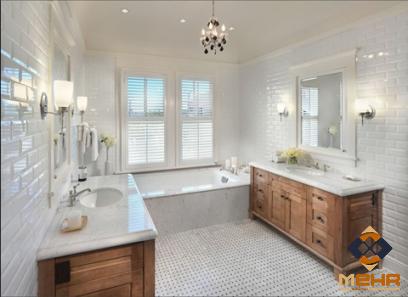When it comes to choosing the right tile for your home or business, there are many factors to consider. One of the most important decisions is whether to opt for unglazed or glazed tile. Both options have their own advantages and disadvantages, so let’s take a closer look at each to help you make an informed choice. Uncgla Unglazed tile, as the name suggests, does not have a layer of glaze applied to its surface. This type of tile is made from natural clay that is fired at a high temperature. Because the clay is porous, unglazed tile tends to absorb liquids more readily than glazed tile. However, this porosity can also be an advantage in certain situations. One of the main benefits of unglazed tile is its slip resistance.

.
 The porous surface provides better traction, making it a suitable choice for areas that are prone to getting wet, such as bathrooms or entryways. This can help prevent accidents and falls, especially in households with elderly people or young children. Additionally, unglazed tile is less likely to show wear and tear over time, as scratches and scuffs are not as noticeable on its rougher surface. Another advantage of unglazed tile is its natural appearance. The clay color of unglazed tile remains consistent throughout its thickness, giving it a rustic and earthy feel. This makes it a popular choice for spaces that aim to achieve a more organic and traditional look. Additionally, unglazed tile is often used in outdoor settings, such as patios and pool decks, due to its slip-resistant properties and durability in varying weather conditions. However, there are some downsides to unglazed tile.
The porous surface provides better traction, making it a suitable choice for areas that are prone to getting wet, such as bathrooms or entryways. This can help prevent accidents and falls, especially in households with elderly people or young children. Additionally, unglazed tile is less likely to show wear and tear over time, as scratches and scuffs are not as noticeable on its rougher surface. Another advantage of unglazed tile is its natural appearance. The clay color of unglazed tile remains consistent throughout its thickness, giving it a rustic and earthy feel. This makes it a popular choice for spaces that aim to achieve a more organic and traditional look. Additionally, unglazed tile is often used in outdoor settings, such as patios and pool decks, due to its slip-resistant properties and durability in varying weather conditions. However, there are some downsides to unglazed tile.
..
 Its porous surface can make it more prone to staining, particularly in areas where spills are common, such as kitchens or dining rooms. To mitigate this issue, regular sealing is recommended to protect the tile and make it easier to clean. Additionally, unglazed tile requires more maintenance and cleaning compared to glazed tile, as dirt and grime can easily accumulate in its pores. On the other hand, glazed tile is covered with a layer of liquid glass before being fired in a kiln. This glaze provides a protective barrier that makes the tile more resistant to stains, scratches, and wear. Additionally, glazed tile is available in a wide range of colors, patterns, and finishes, making it a versatile choice for various design aesthetics. One of the main advantages of glazed tile is its ease of maintenance. The smooth and sealed surface of glazed tile makes it easy to clean, as spills and stains can be wiped away effortlessly.
Its porous surface can make it more prone to staining, particularly in areas where spills are common, such as kitchens or dining rooms. To mitigate this issue, regular sealing is recommended to protect the tile and make it easier to clean. Additionally, unglazed tile requires more maintenance and cleaning compared to glazed tile, as dirt and grime can easily accumulate in its pores. On the other hand, glazed tile is covered with a layer of liquid glass before being fired in a kiln. This glaze provides a protective barrier that makes the tile more resistant to stains, scratches, and wear. Additionally, glazed tile is available in a wide range of colors, patterns, and finishes, making it a versatile choice for various design aesthetics. One of the main advantages of glazed tile is its ease of maintenance. The smooth and sealed surface of glazed tile makes it easy to clean, as spills and stains can be wiped away effortlessly.
…
 This makes glazed tile a popular choice for high-traffic areas, such as kitchens and commercial spaces. Glazed tile also offers more design options compared to unglazed tile. The glaze can be customized with different colors, patterns, and textures, allowing for endless possibilities in creating unique and eye-catching spaces. The glossy finish of glazed tile can also add a touch of elegance and sophistication to any area. However, there are some drawbacks to consider when choosing glazed tile. The smooth surface can be slippery when wet, so it may not be the best choice for areas that are prone to water exposure. Additionally, the glaze layer can wear off over time, particularly in high-traffic areas. This can result in a faded appearance and the need for more frequent replacement. In conclusion, the choice between unglazed and glazed tile ultimately depends on your specific needs and preferences. If slip resistance and a natural aesthetic are important to you, unglazed tile may be the way to go. However, if you prioritize easy maintenance and a wide range of design options, glazed tile may be the better choice. Consider your environment, usage, and desired aesthetics to make an informed decision and create a space that suits your style and functional needs.
This makes glazed tile a popular choice for high-traffic areas, such as kitchens and commercial spaces. Glazed tile also offers more design options compared to unglazed tile. The glaze can be customized with different colors, patterns, and textures, allowing for endless possibilities in creating unique and eye-catching spaces. The glossy finish of glazed tile can also add a touch of elegance and sophistication to any area. However, there are some drawbacks to consider when choosing glazed tile. The smooth surface can be slippery when wet, so it may not be the best choice for areas that are prone to water exposure. Additionally, the glaze layer can wear off over time, particularly in high-traffic areas. This can result in a faded appearance and the need for more frequent replacement. In conclusion, the choice between unglazed and glazed tile ultimately depends on your specific needs and preferences. If slip resistance and a natural aesthetic are important to you, unglazed tile may be the way to go. However, if you prioritize easy maintenance and a wide range of design options, glazed tile may be the better choice. Consider your environment, usage, and desired aesthetics to make an informed decision and create a space that suits your style and functional needs.










Your comment submitted.